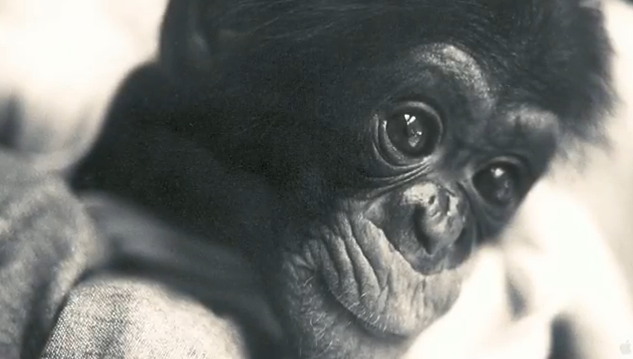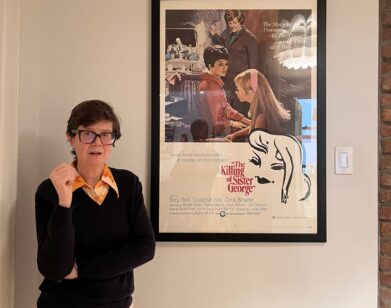Chimp Effect: Project Nim’s Animal Instincts

After releasing Man on Wire, the Oscar-winning 2008 documentary that chronicled Philippe Petit’s famous 1974 tightrope walk from one tower of the World Trade Center to the other, director James Marsh and producer Simon Chinn had a tough act to follow. For their next feature, they managed to find a documentary subject even more elusive than Petit, whose life was even more fraught with tension: Nim Chimpsky, the chimpanzee who learned sign language in a theoretically controlled (but more often out-of-control) ape-language project helmed by Columbia University’s Dr. Herbert Terrace. Nim started his life raised as much like a human child as possible by Stephanie LaFarge, a former student (and lover) of Terrace, with her family in a brownstone on the Upper West Side. He would go on to live in a sprawling estate in Riverdale with researchers and cats for company; a chimp research facility run by NYU; and even a medical testing center.
Each new chapter in Project Nim brings surprises, humor, heartbreak, and (as often as not) terror for the humans involved in raising him, who begin to understand that by immersing Nim in human surroundings, they may have done him more harm than good. And he, five times stronger than a human adult, is more than capable of expressing his dissatisfaction. We talked with Simon Chinn, at last night’s Peggy Siegal Company screening of the film, about the ethics of the project and the current state of documentary filmmaking.
ALEXANDRIA SYMONDS: What initially drew you to the story of Nim?
SIMON CHINN: My wife, Laura. It was after Sundance, and we’d just launched Man on Wire. James Marsh and I were kind of rooting around for our next project. I came down for breakfast one morning, and my wife, Laura, was about six months pregnant, and she was weeping, having read an article [about Nim]. She was touched by Nim’s story. It is, actually, if you think about it, a story that’s about and for parents. So that was what touched her—something kind of primary and maternal in her, in the state that she was in. So that was what drew me initially to the story, and then I read it—I read Elizabeth Hess’s book, and it is just the most amazing story, with incredible reversals and twists and turns. If you dramatized it, if you did it as a dramatic feature film, people wouldn’t believe it.
SYMONDS: What challenges did you find in telling the story?
CHINN: Well, it’s a very complex story; it takes place over 26 years.
SYMONDS: That’s one thing I was curious about—what you ended up finding you had to leave out.
CHINN: When you compress 26 years into 93 minutes, you end up having to make some tough choices about things to omit. And as with any film, you have to, to some extent, tell it in fairly broad brush strokes but hope that you get to some sort of emotional, dramatic, or narrative truth. And it is a film with 13, 14 important witnesses, lots of scientific ideas we had to address. But we were very keen for the film to transcend its scientific subject. Project Nim, the scientific experiment, really forms only part of Nim’s early life. We wanted to tell Nim’s full story—it was an opportunity to do it as a sort of biography of an animal, which feels like it hasn’t been done.
SYMONDS: I was actually wondering whether you felt like you had the shadow of Koko: A Talking Gorilla hanging over you, at any point.
CHINN: Babette Schröder made that film, and obviously we watched that, we watched the film about the Yerkes Primate Institute by Fred Wiseman, and those are very different kinds of films—they’re observational films. Here, we were presented with a story that had happened, so we kind of knew the parameters of that story. We knew the witnesses we wanted to gather to tell it, we hoped there would be the archive there to illustrate it. So then it was just a question of constructing it. It’s very different from making an observational film where you go in, make a leap of faith, and hope that you come away with something worthwhile—actually, that’s probably a little bit harder.
SYMONDS: Are you an animal person yourself? Do you have pets?
CHINN: I would describe myself as an animal lover, I had a dog growing up, and I’d very much like for my two-year-old to have a dog at the right moment. But I’m a little bit wary, because I have to say, I’m someone who feels that the care of an animal is a big responsibility. That’s a big question that this film raises: what responsibility do we have to other species, and indeed, our own kind, when they’re more vulnerable than we are? We have a duty of care to them.
SYMONDS: It seems like there are a lot of animal-ethics issues being raised in documentary right now. The animal cloning in Tabloid…
CHINN: Sure. One other film I haven’t seen is Buck, which is about a horse whisperer. Project Nim is probably quite different from a lot of those films. One thing we tried to achieve in the film was to be careful about projecting onto Nim—that does certainly happen throughout his life in many ways, and we didn’t want to sentimentalize or even anthropomorphize the chimp.
SYMONDS: Do you feel like we’re in a golden age of documentary right now? It seems like this, like Man on Wire, is a film that has a lot of mainstream appeal, and maybe people who wouldn’t have been going to see documentaries in the past are going to see them now.
CHINN: I think the golden age of documentary has been with us for some time. I think there are a number of key documentaries that I can think of that have engaged cinema audiences very powerfully. And hopefully, what we’ve tried to do is to diminish the distinction between documentary and dramatic feature films. The sense, I hope, is that people will end up feeling that the “documentary” tag is somewhat incidental, and that actually documentaries have the power to enrich and engage audiences with the very best fiction films. That might be nice.
SYMONDS: That’s a good way of putting it.
CHINN: It’s always difficult to ask audiences to pay to go and see documentaries, and I think that’s partially because traditionally, documentaries’ purpose was perhaps to educate and inform. But actually, our purpose with Nim and Man on Wire and many other films out there is simply to tell a good story in the best way possible.
PROJECT NIM IS OUT IN THEATERS ON JULY 8.






